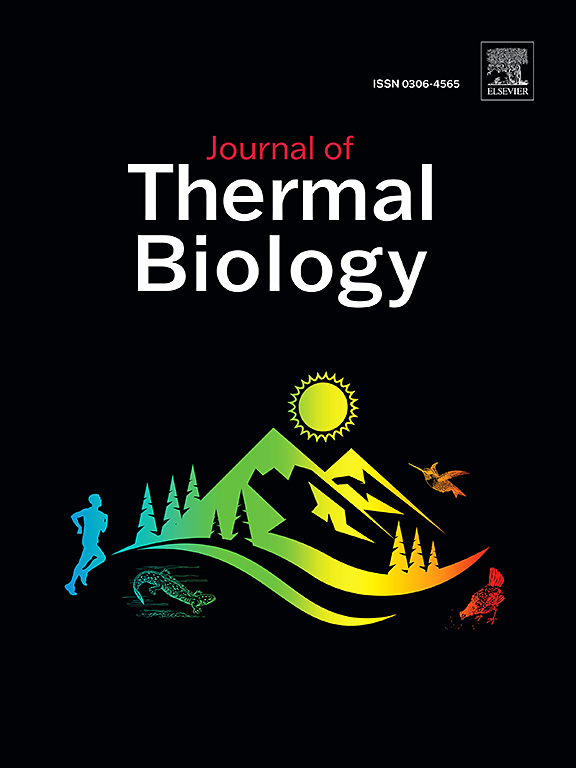在高温下运动时,月经周期对体温调节的影响。
IF 2.9
2区 生物学
Q2 BIOLOGY
引用次数: 0
摘要
由于与月经周期相关的激素变化,女性可能面临维持体温调节的挑战。本研究的目的是评估月经周期阶段对核心温度、水合状态和在不可补偿的热增益下运动时感知的运动强度的影响。11名初潮妇女(24.4±1.1岁,65.7±2.4 kg, 22.7±1.5%体脂)在卵泡早期(EF)和黄体中期(ML)的热室(35°C和30%相对湿度)中行走180分钟。受试者以50%最大摄氧量完成三个间隔50分钟的运动。在两项试验中均测量了生理应变指数(PSI)、核心温度(TC)、感知热(PH)和感知劳累等级(RPE)。试验前后分别采集裸体体重(NBW)和血液样本。分析血液样本的红细胞压积(Hct)、血红蛋白(Hb)、血清雌激素、孕酮和醛固酮。NBW的主要影响因素是时间(p = 0.002, ηp = 0.62)。醛固酮主要影响时间(p = 0.004, ηp2 = 0.59)和相(p = 0.014, ηp2 = 0.47),运动后EF和ML均达到峰值(分别为527.6.1±89.0 pg·ML -1 vs 827.4±129.5 pg·ML -1, p = 0.014)。雌二醇和黄体酮是主要的期效(p = 0.007, ηp2 = 0.53;p = 0.045,ηp2 = 0.30),但不是时间(p = 0.68, p = 0.32)。时间(p = 0.89)和相(p = 0.032, η = 0.38)对温度的影响最大,在170 min达到峰值(EF: 37.8±0.1°C vs. ML: 38.0±0.1°C)。主要影响的时间看到了PSI (p = 0.002,ηp2 = 0.88), PH值(p = 0.004,ηp2 = 0.66),和RPE (p = 0.026,ηp2 = 0.80)。汗液率、Hct、Hb和脱水率在两相间无显著差异。总之,受试者在ML中表现出Tc和基础醛固酮升高,与雌激素和孕酮升高相对应。热环境下运动后醛固酮显著增加,但在热环境下运动时仍保持升高。这些结果表明,在热环境下运动时,尽管两阶段之间感知到的热量和努力相似,但热环境下运动时的Tc升高仍保持不变。本文章由计算机程序翻译,如有差异,请以英文原文为准。

Menstrual cycle effects on thermoregulation while exercising in the heat
Women may be challenged to maintain thermoregulation due to hormonal changes associated with the menstrual cycle. The purpose of this study was to assess the effect of the menstrual cycle phase on core temperature, hydration status, and perceived exertion while exercising under uncompensable heat gain. Eleven eumenorrheic women (24.4 ± 1.1 yrs, 65.7 ± 2.4 kg, 22.7 ± 1.5% body fat) walked for two 180-min trials in a heat chamber (35 °C and 30% relative humidity) during early-follicular (EF) and mid-luteal (ML) phases. Subjects completed three intervals of 50 min of exercise at 50% VO2max. Physiological strain index (PSI), core temperature (TC), perceived heat (PH), and rating of perceived exertion (RPE) were measured throughout both trials. Nude body weight (NBW) and blood samples were collected pre- and post-trial. Blood samples were analyzed for hematocrit (Hct), hemoglobin (Hb), serum estrogen, progesterone, and aldosterone. NBW showed a main effect of time (p = 0.002, ηp2 = 0.62). Aldosterone showed main effect of time (p = 0.004, ηp2 = 0.59) and phase (p = 0.014, ηp2 = 0.47), peaking post exercise in both EF and ML (527.6.1 ± 89.0 pg·mL−1 vs 827.4 ± 129.5 pg mL−1 respectively, p = 0.014). Estradiol and progesterone showed main effects of phase (p = 0.007, ηp2 = 0.53; p = 0.045, ηp2 = 0.30) but not time (p = 0.68, p = 0.32). TC showed main effect of time (p < 0.001, ηp2 = 0.89) and phase, peaking at 170 min (EF: 37.8 ± 0.1 °C vs. ML: 38.0 ± 0.1 °C, p = 0.032, ηp2 = 0.38). Main effect of time was seen for PSI (p = 0.002, ηp2 = 0.88), PH (p = 0.004, ηp2 = 0.66), and RPE (p = 0.026, ηp2 = 0.80). Sweat rate, Hct, Hb, and percent dehydration were not different between the phases. In conclusion, subjects demonstrated elevated Tc and basal aldosterone in ML corresponding with elevations in estrogen and progesterone. Aldosterone significantly increased following exercise in the heat but remained elevated in ML. These results indicate that elevated Tc during ML is maintained during exercise in the heat despite similar perceived heat and effort between phases.
求助全文
通过发布文献求助,成功后即可免费获取论文全文。
去求助
来源期刊

Journal of thermal biology
生物-动物学
CiteScore
5.30
自引率
7.40%
发文量
196
审稿时长
14.5 weeks
期刊介绍:
The Journal of Thermal Biology publishes articles that advance our knowledge on the ways and mechanisms through which temperature affects man and animals. This includes studies of their responses to these effects and on the ecological consequences. Directly relevant to this theme are:
• The mechanisms of thermal limitation, heat and cold injury, and the resistance of organisms to extremes of temperature
• The mechanisms involved in acclimation, acclimatization and evolutionary adaptation to temperature
• Mechanisms underlying the patterns of hibernation, torpor, dormancy, aestivation and diapause
• Effects of temperature on reproduction and development, growth, ageing and life-span
• Studies on modelling heat transfer between organisms and their environment
• The contributions of temperature to effects of climate change on animal species and man
• Studies of conservation biology and physiology related to temperature
• Behavioural and physiological regulation of body temperature including its pathophysiology and fever
• Medical applications of hypo- and hyperthermia
Article types:
• Original articles
• Review articles
 求助内容:
求助内容: 应助结果提醒方式:
应助结果提醒方式:


